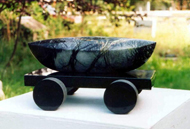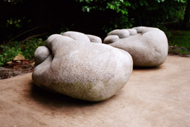Who are you?
VS: Born and raised in Germany, I came to the northwest 32 years ago, living in Seattle for 19 years before moving to live and work in Arlington in 1995.
What is your life history as it relates to being an artist?
VS: I cannot remember not being (what later was defined as…) an artist. From the beginning I had the need to make things with my hands, to draw, paint, shape things out of clay.
At about 4 years old I did a drawing of ‘Little Red Riding Hood’ on the edge of a newspaper. No one believed that I could have drawn it. I felt a little miffed about that and here came the first inkling that I was different, that what was so natural for me was not the ability of everybody.
Later, against all better advice from my elders I proceeded to study art, but because the same elders said “you will be starving as an artist,” (at times they have proven to be right) I gave in to the choice of becoming an art teacher, earned a B.A. degree at the University of Hamburg and the Art School of Hamburg.
This is a wonderful school with great freedom of personal expression and excellent studios. I did clay sculpture, silver smithing, silk screening, welding, plus my favorite: lithography. This printing with sandstone I continued for three years.
After graduation I immigrated to the United States and tried my hand at different jobs and business ventures, all fairly successful but never fulfilling. So, throughout those early years here in the U.S., I always returned to painting in between and during other occupations.
Somewhere the priorities switched and art became the main activity, with supportive jobs on the side. When I found out how to make stone sculptures the excitement was strong enough - and later a lucky break with a large commission helped - for me to be able to make art my sole occupation and income. This I have been able to maintain for about 5 years now…. It’s seldom easy; there are some times of feast and plenty of famine.
Why is art important to you?
VS: Personally art is important to me because of my given talents. They want to be used and expressed. On another level, art is important because it is one of the ingredients of culture. Thirdly, I think that if we are lucky our art can express the real value of things. What do I mean by this? Art conveys emotions, thought and comment on the human condition as it relates to other humans and earth, the universe. To me the real value of things is not denoted by a dollar value, but as a value that pertains to nature: inter-human relations, uplifting of the human spirit, and the learning experiences of life.
Describe your art.
VS: My stone art seems very much part of earth, for one of course, because of the material (which is earth), but also because of the shapes and finishes.
I often feel that if one of my pieces were dropped somewhere in the mountains or into a river, it would blend right in, be part of the natural surrounding without sticking out as manmade. Because of this I have stated before that I work to preserve the “rock-ness” of my boulders and add just a little bit of my human imprint.
Is your sculpture representational or abstract?
VS: There does not seem to be a definite line between these two, just maybe a degree of abstraction leading further away from imitating given forms of humans or things. Total representation appears to be a never-reached goal, perhaps not even desirable. Michelangelo, who beautifully carved every vein and muscle, idealized his forms to a standard of beauty and expression according to his own vision. He did not aim to make precise copies of humans.
On the other end of the spectrum is total abstraction; lets say an oblong block of stone, which we humans with our anthropocentric perception tend to relate to the human form somehow.
Of course our theme can be an abstract like “the moment when night touches day” or “truth” or “idea,” yet the resulting form will ever be related to human proportions by the viewer. Plus, there is the other aspect that the sculpture itself is never abstract, it is three dimensional and touchable and real in the room. It has a material reality, volume, weight. It exists in reality not in abstraction.
After this little excursion into mind acrobatics, here is my answer: I do figurative, I do abstracts, and stuff in between.
Interesting to me is that expressing personal sentiments or the working out of psychological or emotional dilemmas happens in figurative, human forms for me. For instance, to deal with the start of the Iraq War I sculpted a grieving woman that contains all my frustration, anger, sadness and compassion in regards to that event, and it was carved solely for the reason of depositing these feelings outside myself. The title is “Mother of War”.
One more comment I would like to make regarding the posed question is that I think it is much more difficult to work abstract than representational. One reason seems to be that the possibilities of form are unlimited when just sculpting into a shape, a form that in a best situation should relate or communicate a feeling or emotion – this is very subjective, whereas when one tries to get close to a given subject, human form or otherwise, one has that given shape as a guide and goal to work towards.
How do you get your ideas?
VS: Frankly it feels as if the ideas come from nowhere (or somewhere out there) and enter my head, my body. It’s such a high.
There are, however, several approaches to invite them. One way is to sit and look at a selected stone. While looking at it, play out in your head many different ideas of what to do with it: do visual sculpting so to speak. Hundreds of ideas may be tried out this way – this probing might take a few hours or a few days, or more – until the bells and whistles go off, the light comes on and there is a feeling of certainty that this idea is it. The inspiration has entered, the excitement is here, and the surety that this is the perfect idea is present.
Uchida-san calls this “To wait until the spirit enters.”
Another approach is to just start sawing or grinding on a rock and see what develops according to one’s own form vocabulary. Yet another way is to have a preconceived idea and search for the right rock to implement it.

How do you develop your ideas?
VS: A few times I have worked from forms I drew beforehand. I mostly only sketch as a memory aide for ideas that tumble through my head. A couple of times I have used clay, plaster or balsa wood to visualize an idea in a solid material in three dimensions.
My favorite way to sculpt the stone is intuitively, though. This means to follow that above-described inspiration and see what it looks like in the stone, how it translates into the quality of the material, how it works in reality with the tools at hand. This means a lot of stepping back, sometimes far away, and looking and adjusting that initial idea and letting it flow with the given form.
At art school we were always told to develop our personal form language. This is as true for painting as it is for sculpture and can only be done by creating many pieces of art. This personal form canon is the language with which we translate the ideas into works of art. After years of sculpting we might not be aware that we are creating within this language. It is as much a tool for expression and realization, as it makes our art our own creation, recognizable as ours alone.
What stones do you prefer?
VS: Granite is my favorite medium; in fact I am hooked on it. Most of my work, with few exceptions, is of granite. Why? I like the way it breaks, the way it looks, the variety of the grains, the liveliness of it.
Furthermore I like that it comes in boulders of all sizes, especially large ones that after their long travels in the ice and rivers are already carved, sometimes to perfect oval or round shapes. Our neighborhood mountains consist mostly of granite. I like that fact, as I prefer to use the stone of the neighborhood.
Also, granite stands up to our climate well and lasts a long time. I sculpt outside and make sculptures that should live outside. I regard my pieces as postcards to the future and tell my clients that with any luck their sculpture might be around ten thousand years from now.
What is your favorite tool?
VS: My most used and favored tool is decidedly the air hammer with bushing chisels. It enables me to form that hard stone into rounded and soft shapes and create beautiful surfaces. The buzz of the air hammer also seems like a meditative aid to me. I get my best ideas and solve a lot of problems when I am hearing it through my earmuffs.
What is the major theme and intent of your art?
VS: Oye veh, what a question! My first answer to this question should be: I don’t know. I just make them; I have to create something with my hands. Seems to me my intent can only be deduced after the fact, analyzed from the finished body of work perhaps.
Lately I have sculpted a series of pieces about water. The rarity of it, the scarcity of it in some countries of the world, it being the basic building block of life, the fact that I cannot drink water from the natural creeks without danger to my health, the fluidity of it and so on…are all things I think about during the course of the day and try to work out in my stone sculptures.
Another theme I have elaborated on is Time, different concepts of movement of time and time expressed in old materials, like rock etc. These are subjects that occupy my mind, so I try to work with them in my sculpture. (I don’t have a television, hence I have a lot of time to think about such things.)
Maybe one of my general intents is my striving to imbue my forms with a pulse. This is a quality of aliveness, of movement, even of enhancing of a personality of the sculpture. It is solely a visual characteristic and underlined and achieved by roundness, especially convex curves and domes, it seems to me.
Finally I want to say that at first I disliked answering the questions for this interview. They present a demand for reflection and probing into ones motivation and process, something I resist doing. Then I found out that exactly this fact makes it fun and is of course of great value to myself and to the development of my art.
Putting thoughts into words is not my most important artistic endeavor, I am foremost a visual artist, but it surely helps to clarify directions and systems in my own head and hopefully helps to explain what I am trying to do in my sculpture.
Furthermore, I want to say that without NWSSA I would not be where I am now. I learned how to carve the granite at the symposium at Camp Brotherhood about 10 years ago and have been able to pursue my passion as an artist because of the generosity of my teachers and friends in this organization. No finer group of supporters and friends can be found anywhere else.
Ed. note: you can see some of Verena’s work at: www.verena-schwippert.com.

